Galeria de retlaw snellac
india - ladakh - zanskar - kasjmir - himachal pradesh
A trip starting in Srinagar and ending in Delhi with a lot of highlights in the Zanskar valley and in Ladakh.
See also:
www.flickriver.com/photos/waltercallens/ random/
www.flickr.com/photos/waltercallens/favo rites/
english.cohga.net/flickr/user/74089637@N 00_1.html
www.fluidr.com/photos/waltercallens/sets
www.lurvely.com/index.php?owner=74089637 @N00
Created with Admarket's flickrSLiDR.
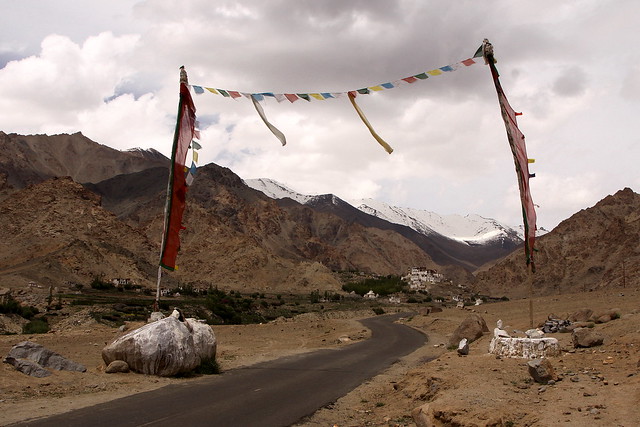
india - ladakh
Likir Gompa (Monastery in Ladakh).
The name Likir means "The Naga - Encircled". The reason behind this naming of Likir Gompa of Ladakh is that it stands surrounded by the bodies of the two great serpent spirits, the Naga-rajas, Nanda and Taksako. The monastery is situated at a distance of approximately 62 km to the west of Leh town. Lhachen Gyalpo, the fifth king of Ladakh, offered the site where the monastery now stands, to Lama Duwang Chosje. The Lama, a great champion of meditation, blessed the site offered to him, after which the construction on the monastery was undertaken.
The Likir Monastery belongs to the Yellow Hat Sect, founded by Tsongkhapa. It consists of a number of shrines inside its complex. Presently, it serves as the residence of approximately 120 Buddhist monks. The monastery also has a school, in which almost thirty students study. In the 15th century, Likir Gompa came under the influence of Lodos Sangphu. A disciple of Khasdubje, he made efforts to see that the monastery flourished and prospered.
From that time onwards and till today, the monastery continues to be under the Tsongkhapa order. The ritual of the three basic Pratimoksa disciplines, the basic Buddhist teachings, are observed at the Likir Monastery, even in the present times. The Gompa also serves as the venue of an annual event Dosmochey, the assembly of votive offerings. This event takes place from 27th day to 29th day of the 12th month of the Tibetan calendar. During Dosmochey, sacred dances are also performed at the monastery.
The Likir Gompa Ladakh has been served by the succeeding reincarnations of Naris Rinpoche, since quite a long time and continues to do so. The monastery also houses a protective deity, which stands inside, wearing a golden armor. There are two Dukhangs (assembly halls) inside the monastery, one of them relatively new. The older one is on the right of the central courtyard of the monastery and comprises of six rows of seats for the lamas.
Inside this Dukhang are the statues of Bodhisattva (Lord of All He Surveys), Amitabha (Buddha of the West), Sakyamuni (the Historical Buddha), Maitreya (the Future Buddha or Buddha of Compassion) and Tsong-kha-pa (Founder of the yellow-hat sect). After you exit from this Dukhang, you will see the new Dukhang, diagonally across from the courtyard's entrance. The main image in the new Dukhang is that of Avalokitesvara, with 1000 arms and 11 heads.
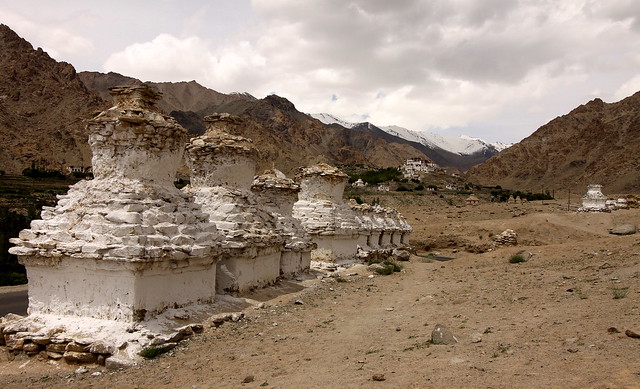
india - ladakh
Likir Gompa (Monastery in Ladakh).
The name Likir means "The Naga - Encircled". The reason behind this naming of Likir Gompa of Ladakh is that it stands surrounded by the bodies of the two great serpent spirits, the Naga-rajas, Nanda and Taksako. The monastery is situated at a distance of approximately 62 km to the west of Leh town. Lhachen Gyalpo, the fifth king of Ladakh, offered the site where the monastery now stands, to Lama Duwang Chosje. The Lama, a great champion of meditation, blessed the site offered to him, after which the construction on the monastery was undertaken.
The Likir Monastery belongs to the Yellow Hat Sect, founded by Tsongkhapa. It consists of a number of shrines inside its complex. Presently, it serves as the residence of approximately 120 Buddhist monks. The monastery also has a school, in which almost thirty students study. In the 15th century, Likir Gompa came under the influence of Lodos Sangphu. A disciple of Khasdubje, he made efforts to see that the monastery flourished and prospered.
From that time onwards and till today, the monastery continues to be under the Tsongkhapa order. The ritual of the three basic Pratimoksa disciplines, the basic Buddhist teachings, are observed at the Likir Monastery, even in the present times. The Gompa also serves as the venue of an annual event Dosmochey, the assembly of votive offerings. This event takes place from 27th day to 29th day of the 12th month of the Tibetan calendar. During Dosmochey, sacred dances are also performed at the monastery.
The Likir Gompa Ladakh has been served by the succeeding reincarnations of Naris Rinpoche, since quite a long time and continues to do so. The monastery also houses a protective deity, which stands inside, wearing a golden armor. There are two Dukhangs (assembly halls) inside the monastery, one of them relatively new. The older one is on the right of the central courtyard of the monastery and comprises of six rows of seats for the lamas.
Inside this Dukhang are the statues of Bodhisattva (Lord of All He Surveys), Amitabha (Buddha of the West), Sakyamuni (the Historical Buddha), Maitreya (the Future Buddha or Buddha of Compassion) and Tsong-kha-pa (Founder of the yellow-hat sect). After you exit from this Dukhang, you will see the new Dukhang, diagonally across from the courtyard's entrance. The main image in the new Dukhang is that of Avalokitesvara, with 1000 arms and 11 heads.
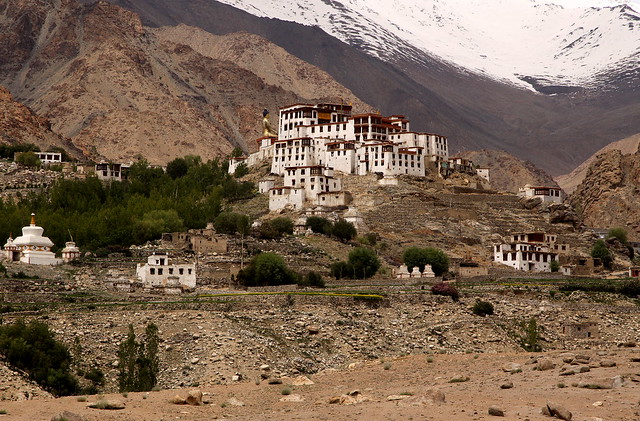
india - ladakh
Likir Gompa (Monastery in Ladakh).
The name Likir means "The Naga - Encircled". The reason behind this naming of Likir Gompa of Ladakh is that it stands surrounded by the bodies of the two great serpent spirits, the Naga-rajas, Nanda and Taksako. The monastery is situated at a distance of approximately 62 km to the west of Leh town. Lhachen Gyalpo, the fifth king of Ladakh, offered the site where the monastery now stands, to Lama Duwang Chosje. The Lama, a great champion of meditation, blessed the site offered to him, after which the construction on the monastery was undertaken.
The Likir Monastery belongs to the Yellow Hat Sect, founded by Tsongkhapa. It consists of a number of shrines inside its complex. Presently, it serves as the residence of approximately 120 Buddhist monks. The monastery also has a school, in which almost thirty students study. In the 15th century, Likir Gompa came under the influence of Lodos Sangphu. A disciple of Khasdubje, he made efforts to see that the monastery flourished and prospered.
From that time onwards and till today, the monastery continues to be under the Tsongkhapa order. The ritual of the three basic Pratimoksa disciplines, the basic Buddhist teachings, are observed at the Likir Monastery, even in the present times. The Gompa also serves as the venue of an annual event Dosmochey, the assembly of votive offerings. This event takes place from 27th day to 29th day of the 12th month of the Tibetan calendar. During Dosmochey, sacred dances are also performed at the monastery.
The Likir Gompa Ladakh has been served by the succeeding reincarnations of Naris Rinpoche, since quite a long time and continues to do so. The monastery also houses a protective deity, which stands inside, wearing a golden armor. There are two Dukhangs (assembly halls) inside the monastery, one of them relatively new. The older one is on the right of the central courtyard of the monastery and comprises of six rows of seats for the lamas.
Inside this Dukhang are the statues of Bodhisattva (Lord of All He Surveys), Amitabha (Buddha of the West), Sakyamuni (the Historical Buddha), Maitreya (the Future Buddha or Buddha of Compassion) and Tsong-kha-pa (Founder of the yellow-hat sect). After you exit from this Dukhang, you will see the new Dukhang, diagonally across from the courtyard's entrance. The main image in the new Dukhang is that of Avalokitesvara, with 1000 arms and 11 heads.

india - ladakh
Likir Gompa (Monastery in Ladakh).
The name Likir means "The Naga - Encircled". The reason behind this naming of Likir Gompa of Ladakh is that it stands surrounded by the bodies of the two great serpent spirits, the Naga-rajas, Nanda and Taksako. The monastery is situated at a distance of approximately 62 km to the west of Leh town. Lhachen Gyalpo, the fifth king of Ladakh, offered the site where the monastery now stands, to Lama Duwang Chosje. The Lama, a great champion of meditation, blessed the site offered to him, after which the construction on the monastery was undertaken.
The Likir Monastery belongs to the Yellow Hat Sect, founded by Tsongkhapa. It consists of a number of shrines inside its complex. Presently, it serves as the residence of approximately 120 Buddhist monks. The monastery also has a school, in which almost thirty students study. In the 15th century, Likir Gompa came under the influence of Lodos Sangphu. A disciple of Khasdubje, he made efforts to see that the monastery flourished and prospered.
From that time onwards and till today, the monastery continues to be under the Tsongkhapa order. The ritual of the three basic Pratimoksa disciplines, the basic Buddhist teachings, are observed at the Likir Monastery, even in the present times. The Gompa also serves as the venue of an annual event Dosmochey, the assembly of votive offerings. This event takes place from 27th day to 29th day of the 12th month of the Tibetan calendar. During Dosmochey, sacred dances are also performed at the monastery.
The Likir Gompa Ladakh has been served by the succeeding reincarnations of Naris Rinpoche, since quite a long time and continues to do so. The monastery also houses a protective deity, which stands inside, wearing a golden armor. There are two Dukhangs (assembly halls) inside the monastery, one of them relatively new. The older one is on the right of the central courtyard of the monastery and comprises of six rows of seats for the lamas.
Inside this Dukhang are the statues of Bodhisattva (Lord of All He Surveys), Amitabha (Buddha of the West), Sakyamuni (the Historical Buddha), Maitreya (the Future Buddha or Buddha of Compassion) and Tsong-kha-pa (Founder of the yellow-hat sect). After you exit from this Dukhang, you will see the new Dukhang, diagonally across from the courtyard's entrance. The main image in the new Dukhang is that of Avalokitesvara, with 1000 arms and 11 heads.
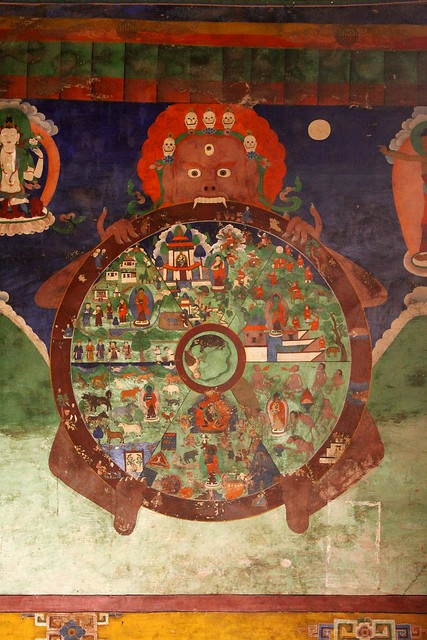
india - ladakh
Likir Gompa (Monastery in Ladakh).
The name Likir means "The Naga - Encircled". The reason behind this naming of Likir Gompa of Ladakh is that it stands surrounded by the bodies of the two great serpent spirits, the Naga-rajas, Nanda and Taksako. The monastery is situated at a distance of approximately 62 km to the west of Leh town. Lhachen Gyalpo, the fifth king of Ladakh, offered the site where the monastery now stands, to Lama Duwang Chosje. The Lama, a great champion of meditation, blessed the site offered to him, after which the construction on the monastery was undertaken.
The Likir Monastery belongs to the Yellow Hat Sect, founded by Tsongkhapa. It consists of a number of shrines inside its complex. Presently, it serves as the residence of approximately 120 Buddhist monks. The monastery also has a school, in which almost thirty students study. In the 15th century, Likir Gompa came under the influence of Lodos Sangphu. A disciple of Khasdubje, he made efforts to see that the monastery flourished and prospered.
From that time onwards and till today, the monastery continues to be under the Tsongkhapa order. The ritual of the three basic Pratimoksa disciplines, the basic Buddhist teachings, are observed at the Likir Monastery, even in the present times. The Gompa also serves as the venue of an annual event Dosmochey, the assembly of votive offerings. This event takes place from 27th day to 29th day of the 12th month of the Tibetan calendar. During Dosmochey, sacred dances are also performed at the monastery.
The Likir Gompa Ladakh has been served by the succeeding reincarnations of Naris Rinpoche, since quite a long time and continues to do so. The monastery also houses a protective deity, which stands inside, wearing a golden armor. There are two Dukhangs (assembly halls) inside the monastery, one of them relatively new. The older one is on the right of the central courtyard of the monastery and comprises of six rows of seats for the lamas.
Inside this Dukhang are the statues of Bodhisattva (Lord of All He Surveys), Amitabha (Buddha of the West), Sakyamuni (the Historical Buddha), Maitreya (the Future Buddha or Buddha of Compassion) and Tsong-kha-pa (Founder of the yellow-hat sect). After you exit from this Dukhang, you will see the new Dukhang, diagonally across from the courtyard's entrance. The main image in the new Dukhang is that of Avalokitesvara, with 1000 arms and 11 heads.
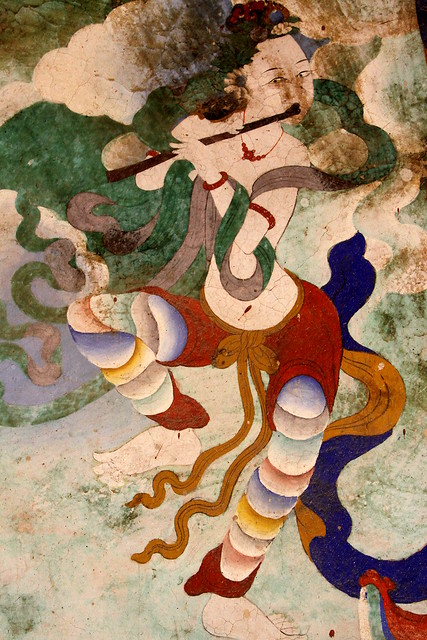
india - ladakh
Likir Gompa (Monastery in Ladakh).
The name Likir means "The Naga - Encircled". The reason behind this naming of Likir Gompa of Ladakh is that it stands surrounded by the bodies of the two great serpent spirits, the Naga-rajas, Nanda and Taksako. The monastery is situated at a distance of approximately 62 km to the west of Leh town. Lhachen Gyalpo, the fifth king of Ladakh, offered the site where the monastery now stands, to Lama Duwang Chosje. The Lama, a great champion of meditation, blessed the site offered to him, after which the construction on the monastery was undertaken.
The Likir Monastery belongs to the Yellow Hat Sect, founded by Tsongkhapa. It consists of a number of shrines inside its complex. Presently, it serves as the residence of approximately 120 Buddhist monks. The monastery also has a school, in which almost thirty students study. In the 15th century, Likir Gompa came under the influence of Lodos Sangphu. A disciple of Khasdubje, he made efforts to see that the monastery flourished and prospered.
From that time onwards and till today, the monastery continues to be under the Tsongkhapa order. The ritual of the three basic Pratimoksa disciplines, the basic Buddhist teachings, are observed at the Likir Monastery, even in the present times. The Gompa also serves as the venue of an annual event Dosmochey, the assembly of votive offerings. This event takes place from 27th day to 29th day of the 12th month of the Tibetan calendar. During Dosmochey, sacred dances are also performed at the monastery.
The Likir Gompa Ladakh has been served by the succeeding reincarnations of Naris Rinpoche, since quite a long time and continues to do so. The monastery also houses a protective deity, which stands inside, wearing a golden armor. There are two Dukhangs (assembly halls) inside the monastery, one of them relatively new. The older one is on the right of the central courtyard of the monastery and comprises of six rows of seats for the lamas.
Inside this Dukhang are the statues of Bodhisattva (Lord of All He Surveys), Amitabha (Buddha of the West), Sakyamuni (the Historical Buddha), Maitreya (the Future Buddha or Buddha of Compassion) and Tsong-kha-pa (Founder of the yellow-hat sect). After you exit from this Dukhang, you will see the new Dukhang, diagonally across from the courtyard's entrance. The main image in the new Dukhang is that of Avalokitesvara, with 1000 arms and 11 heads.
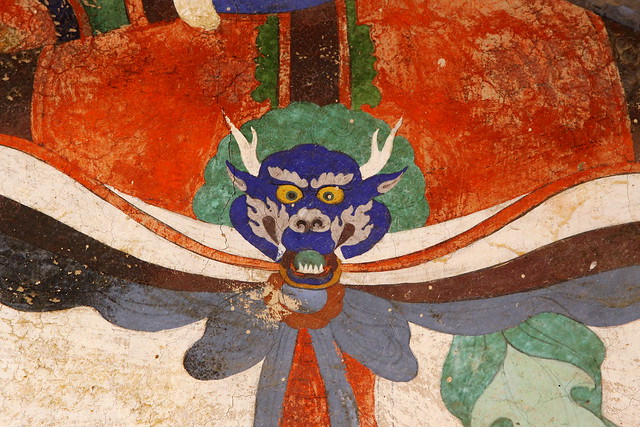
india - ladakh
Likir Gompa (Monastery in Ladakh).
The name Likir means "The Naga - Encircled". The reason behind this naming of Likir Gompa of Ladakh is that it stands surrounded by the bodies of the two great serpent spirits, the Naga-rajas, Nanda and Taksako. The monastery is situated at a distance of approximately 62 km to the west of Leh town. Lhachen Gyalpo, the fifth king of Ladakh, offered the site where the monastery now stands, to Lama Duwang Chosje. The Lama, a great champion of meditation, blessed the site offered to him, after which the construction on the monastery was undertaken.
The Likir Monastery belongs to the Yellow Hat Sect, founded by Tsongkhapa. It consists of a number of shrines inside its complex. Presently, it serves as the residence of approximately 120 Buddhist monks. The monastery also has a school, in which almost thirty students study. In the 15th century, Likir Gompa came under the influence of Lodos Sangphu. A disciple of Khasdubje, he made efforts to see that the monastery flourished and prospered.
From that time onwards and till today, the monastery continues to be under the Tsongkhapa order. The ritual of the three basic Pratimoksa disciplines, the basic Buddhist teachings, are observed at the Likir Monastery, even in the present times. The Gompa also serves as the venue of an annual event Dosmochey, the assembly of votive offerings. This event takes place from 27th day to 29th day of the 12th month of the Tibetan calendar. During Dosmochey, sacred dances are also performed at the monastery.
The Likir Gompa Ladakh has been served by the succeeding reincarnations of Naris Rinpoche, since quite a long time and continues to do so. The monastery also houses a protective deity, which stands inside, wearing a golden armor. There are two Dukhangs (assembly halls) inside the monastery, one of them relatively new. The older one is on the right of the central courtyard of the monastery and comprises of six rows of seats for the lamas.
Inside this Dukhang are the statues of Bodhisattva (Lord of All He Surveys), Amitabha (Buddha of the West), Sakyamuni (the Historical Buddha), Maitreya (the Future Buddha or Buddha of Compassion) and Tsong-kha-pa (Founder of the yellow-hat sect). After you exit from this Dukhang, you will see the new Dukhang, diagonally across from the courtyard's entrance. The main image in the new Dukhang is that of Avalokitesvara, with 1000 arms and 11 heads.
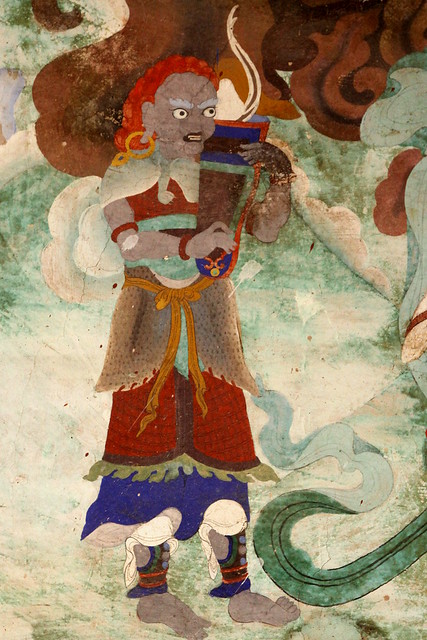
india - ladakh
Likir Gompa (Monastery in Ladakh).
The name Likir means "The Naga - Encircled". The reason behind this naming of Likir Gompa of Ladakh is that it stands surrounded by the bodies of the two great serpent spirits, the Naga-rajas, Nanda and Taksako. The monastery is situated at a distance of approximately 62 km to the west of Leh town. Lhachen Gyalpo, the fifth king of Ladakh, offered the site where the monastery now stands, to Lama Duwang Chosje. The Lama, a great champion of meditation, blessed the site offered to him, after which the construction on the monastery was undertaken.
The Likir Monastery belongs to the Yellow Hat Sect, founded by Tsongkhapa. It consists of a number of shrines inside its complex. Presently, it serves as the residence of approximately 120 Buddhist monks. The monastery also has a school, in which almost thirty students study. In the 15th century, Likir Gompa came under the influence of Lodos Sangphu. A disciple of Khasdubje, he made efforts to see that the monastery flourished and prospered.
From that time onwards and till today, the monastery continues to be under the Tsongkhapa order. The ritual of the three basic Pratimoksa disciplines, the basic Buddhist teachings, are observed at the Likir Monastery, even in the present times. The Gompa also serves as the venue of an annual event Dosmochey, the assembly of votive offerings. This event takes place from 27th day to 29th day of the 12th month of the Tibetan calendar. During Dosmochey, sacred dances are also performed at the monastery.
The Likir Gompa Ladakh has been served by the succeeding reincarnations of Naris Rinpoche, since quite a long time and continues to do so. The monastery also houses a protective deity, which stands inside, wearing a golden armor. There are two Dukhangs (assembly halls) inside the monastery, one of them relatively new. The older one is on the right of the central courtyard of the monastery and comprises of six rows of seats for the lamas.
Inside this Dukhang are the statues of Bodhisattva (Lord of All He Surveys), Amitabha (Buddha of the West), Sakyamuni (the Historical Buddha), Maitreya (the Future Buddha or Buddha of Compassion) and Tsong-kha-pa (Founder of the yellow-hat sect). After you exit from this Dukhang, you will see the new Dukhang, diagonally across from the courtyard's entrance. The main image in the new Dukhang is that of Avalokitesvara, with 1000 arms and 11 heads.
| |||
| Accueil |Pensées Du Jour | | Galleries | La Bhagavad-gita Telle Qu'elle Est |
| | Le Cours Ultime de la Réalisation du Soi (tm) | | |
| Obtenez la miséricorde spéciale de Krishna en faisant du service de dévotion Aidez Sankarshan Prabhu dans sa mission de répandre la conscience de Krishna partout dans le monde. Une contribution singulière ou mensuelle peut se faire en ligne en allant ici : | Un appel pour votre assistance Sur l’ordre de son maître spirituel, Srila Prabhupada, Sankarshan Prabhu à dédié sa vie au travail extrêmement urgent de répandre la conscience de Krishna partout dans le monde. Le plus la conscience de Krishna se répand, le plus que la souffrance, le manque et la haine sur cette planète seront remplacés par la félicité, l’abondance et l’amour. Voici une opportunité dorée de faire le plus grand bien pour toutes les entités vivantes et de recevoir les bénédictions spéciales du Seigneur. Par conséquent, nous devons, au mesure du possible, sacrifier notre temps, notre énergie et nos ressources pour aider Sankarshan Prabhu dans son travail urgent. Si vous voulez participer d’une façon ou d’une autre, grande ou petite, veuillez écrire à Sankarshan Prabhu en cliquant si dessous : Envoyer un courriel à Sankarshan Prabhu
| de Sankarshan Prabhu |
| ||
| Accueil |Pensées Du Jour | Conférences (en Anglais) | Autres Services| Galleries | Méditations sur la Bhakti Pure | ||
|

Up

TABLA - FUENTES - FONTS
SOUV2
- SOUV2P.TTF - 57 KB
- SOUV2I.TTF - 59 KB
- SOUV2B.TTF - 56 KB
- SOUV2T.TTF - 56 KB
- bai_____.ttf - 46 KB
- babi____.ttf - 47 KB
- bab_____.ttf - 45 KB
- balaram_.ttf - 45 KB
- SCAGRG__.TTF - 73 KB
- SCAGI__.TTF - 71 KB
- SCAGB__.TTF - 68 KB
- inbenr11.ttf - 64 KB
- inbeno11.ttf - 12 KB
- inbeni11.ttf - 12 KB
- inbenb11.ttf - 66 KB
- indevr20.ttf - 53 KB
- Greek font: BibliaLS Normal
- Greek font: BibliaLS Bold
- Greek font: BibliaLS Bold Italic
- Greek font: BibliaLS Italic
- Hebrew font: Ezra SIL
- Hebrew font: Ezra SIL SR
Disculpen las Molestias

Up
Sankarshan Das Adhikari - ANUAL
Conceptos Hinduistas (1428)SC
Aa-Anc · Aga - Ahy · Ai - Akshay · Akshe - Amshum · Ana - Ancie · Ang - Asvayu · Ata - Az · Baa-Baz · Be-Bhak · Bhal-Bu · C · Daa-Daz · De · Dha-Dry · Du-Dy · E · F · Gaa-Gayu · Ge-Gy · Ha-He · Hi-Hy · I · J · K · Ka - Kam · Kan - Khatu · Ki - Ko · Kr - Ku · L · M · N · O · P · R · S · Saa-San · Sap-Shy · Si-Sy · Ta - Te · U · V · Ve-Vy · Y · Z
Conceptos Hinduistas (2919) SK
Aa-Ag · Ah-Am · Ana-Anc · And-Anu · Ap-Ar · As-Ax · Ay-Az · Baa-Baq · Bar-Baz · Be-Bhak · Bhal-Bhy · Bo-Bu · Bra · Brh-Bry · Bu-Bz · Caa-Caq · Car-Cay · Ce-Cha · Che-Chi · Cho-Chu · Ci-Cn · Co-Cy · Daa-Dan · Dar-Day · De · Dha- Dny · Do-Dy · Ea-Eo · Ep-Ez · Faa-Fy · Gaa-Gaq · Gar-Gaz · Ge-Gn · Go · Gra-Gy · Haa-Haq · Har-Haz · He-Hindk · Hindu-Histo · Ho-Hy · Ia-Iq · Ir- Is · It-Iy · Jaa- Jaq · Jar-Jay · Je-Jn · Jo-Jy · Kaa-Kaq · Kar-Kaz · Ke-Kh · Ko · Kr · Ku - Kz · Laa-Laq · Lar-Lay · Le-Ln · Lo-Ly · Maa-Mag · Mah · Mai-Maj · Mak-Maq · Mar-Maz · Mb-Mn · Mo-Mz · Naa-Naq · Nar-Naz · Nb-Nn · No-Nz · Oa-Oz · Paa-Paq · Par-Paz · Pe-Ph · Po-Py · Raa-Raq · Rar-Raz · Re-Rn · Ro-Ry · Saa-Sam · San-Sar · Sas-Sg · Sha-Shy · Sia-Sil · Sim-Sn · So - Sq · Sr - St · Su-Sz · Taa-Taq · Tar-Tay · Te-Tn · To-Ty · Ua-Uq · Ur-Us · Vaa-Vaq · Var-Vaz · Ve · Vi-Vn · Vo-Vy · Waa-Wi · Wo-Wy · Yaa-Yav · Ye-Yiy · Yo-Yu · Zaa-Zy








No hay comentarios:
Publicar un comentario